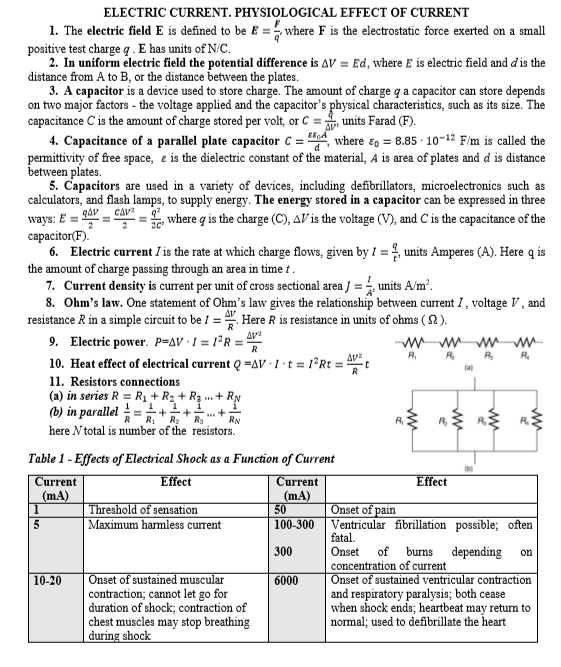ELECTRIC CURRENT. PHYSIOLOGICAL EFFECT OF CURRENT 1. The electric field E is defined to be E =5 where F is the electrostatic force exerted on a small positive test charge q . E has units of N/C. 2. In uniform electric field the potential difference is AV = Ed, where E is electric field and d'is the distance from A to B, or the distance between the plates. 3. A capacitor is a device used to store charge. The amount of charge q a capacitor can store depends on two major factors - the voltage applied and the capacitor's physical characteristics, such as its size. The capacitance C is the amount of charge stored per volt, or C = , units Farad (F). 4. Capacitance of a parallel plate capacitor C = f, where e, = 8.85 - 10-12 F/m is called the permittivity of free space, e is the dielectric constant of the material, A is area of plates and d is distance between plates. 5. Capacitors are used in a variety of devices, including defibrillators, microelectronics such as calculators, and flash lamps, to supply energy. The energy stored in a capacitor can be expressed in three where q is the charge (C), AV'is the voltage (V), and Cis the capacitance of the ways: E = capacitor(F). 6. Electric current I is the rate at which charge flows, given by / =, units Amperes (A). Here q is the amount of charge passing through an area in time t . 7. Current density is current per unit of cross sectional area / = units A/m'. 8. Ohm's law. One statement of Ohm's law gives the relationship between current I, voltage V , and resistance R in a simple circuit to be I = . Here R is resistance in units of ohms ( 2). 9. Electric power. p=AV ·1 = 1°R = 10. Heat effect of electrical current Q =AV 1·t = 1°R¢ = 11. Resistors connections (a) in series R = Rị + R2 + R3 ..+ RN (b) in parallel = + 20" Av2 R. R, (a) R1 here N total is number of the resistors. R2 R3 RN R, Table 1 - Effects of Electrical Shock as a Function of Current Current Effect Current (mA) 50 Effect (mA) | 1 Onset of pain Ventricular fibrillation possible; often fatal. Threshold of sensation Maximum harmless current 100-300 depending 300 Onset of burns concentration of current on Onset of sustained muscular contraction; cannot let go for duration of shock; contraction of chest muscles may stop breathing | during shock Onset of sustained ventricular contraction and respiratory paralysis; both cease when shock ends; heartbeat may return to normal; used to defibrillate the heart 10-20 6000 ww Table 2 Drd not shockedi Cu ow Resistance, Current path Current, A Person (SHOCKEDN Ohms 1300 1000 650 Hgh Vage Hand-body-hand One hand-body-feet Ac S and Load Hands-body-feet Foot-foot 1300
Ohm's law
Ohm’s law is a prominent concept in physics and electronics. It gives the relation between the current and the voltage. It is used to analyze and construct electrical circuits. Ohm's law states that the voltage across a conductor is directly proportional to the current flowing through it.
Path of Least Resistance
In a series of alternate pathways, the direction of least resistance is the actual or metaphorical route that offers the least resistance to forwarding motion by a given individual or body.
Lower voltage and higher frequency are considered less dangerous for human health and life. In the United States of America the standard voltage is 120 V and the frequency is 60 Hz (European standard voltage is 220 V). Calculate the value of a current flowing through a person, for different current paths (Table 2). (b) What was the power dissipated in his body? (c) Using Table 1 make conclusion about physiological effect of these currents. (d) Estimate heat effect of the current if the impact duration was 5 msec?


Step by step
Solved in 5 steps with 12 images




